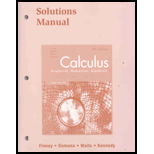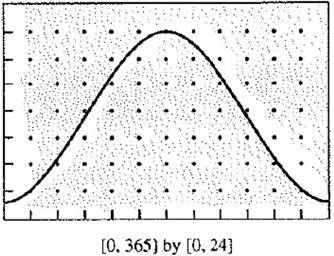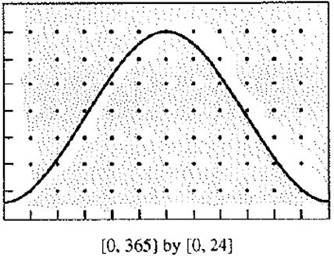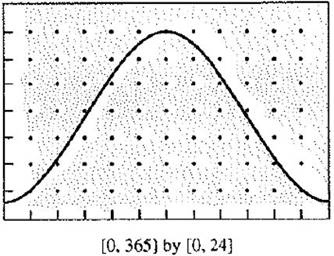
Concept explainers
(a)
Tocalculate:The time rate and the date on which the amount of daylight increasing at the fastest rate.
(a)
Answer to Problem 21E
The required date is April 1st; and the rate is 0.15 hours per day.
Explanation of Solution
Given information:
Starting period is January 1.
End period is December 31.
Each vertical ticks corresponds to 3 hours.
Each month has 30 days.
Daylight graph

Formula Used:
Slop formula of a straight line:
Slop between two points
Calculation:
At the highest point where the graph has the steepest positive curve, the sum of daylight would grow. From the given graph steepest points is at
Given that each month has 30 days, represented by the horizontal ticks.
Thus, after 90 days the month will be April 1.
Now, find the slop at that point,
Here each vertical tick corresponds to 3 hours.
Consider the points of the graph 30 days before and 30 days later than April 1.
Consider 30 days before
Thus the points are (60, 6) and (120, 15).
Calculate the slop between these points. Use the slop formula of a straight line.
Hence, the required date is April 1st; and the rate is 0.15 hours per day.
(b)
The days on which the rate of change in the amount of daylight is zero.
(b)
Answer to Problem 21E
The required days are January 1 and July 1.
Explanation of Solution
Given information:
Starting period is January 1.
End period is December 31.
Each vertical ticks corresponds to 3 hours.
Each month has 30 days.
Daylight graph

If the slop of the graph is zero, the rate of change will be zero.
In the graph the points where the graphstops increasing and starts decreasing or stop decreasing and starts increasing, slop will zero.
There are two points where the slop is zero. These are at
Now, find the month at
From the graph at
At
Hence, the required days are January 1 and July 1.
(c)
The dates on which the rate of change in the number of daylight hours positive.
(c)
Answer to Problem 21E
The rate of change is positive from January 1 to 30 June and the negative rate of change is from July 1 to 31 December.
Explanation of Solution
Given information:
Starting period is January 1.
End period is December 31.
Each vertical ticks corresponds to 3 hours.
Each month has 30 days.
Daylight graph

Find the positive rate of change.
The exchange rate is positive where the graph increases. From the graph it can be seen that the curve is increases from 1 January until 30 June.
Thus, the rate is positive from 1 January to 30 June.
Similarly find the negative rate of change.
The exchange rate is negative if the graph reduces. From the graph it can be seen that the curve is decreases from 1 July to 31 December.
Hence, the rate of change is positive from January 1 to 30 June and the negative rate of change is from July 1 to 31 December.
Conclusion:
Chapter 3 Solutions
Calculus: Graphical, Numerical, Algebraic: Solutions Manual
Additional Math Textbook Solutions
Calculus for Business, Economics, Life Sciences, and Social Sciences (14th Edition)
A First Course in Probability (10th Edition)
A Problem Solving Approach To Mathematics For Elementary School Teachers (13th Edition)
Elementary Statistics
College Algebra with Modeling & Visualization (5th Edition)
Calculus: Early Transcendentals (2nd Edition)
- Evaluate the following integrals as they are writtenarrow_forwardCalculus lll May I please have the blank lines completed, and final statement defined as a result? Thank you for the support!arrow_forward3. Consider the polynomial equation 6-iz+7z² - iz³ +z = 0 for which the roots are 3i, -2i, -i, and i. (a) Verify the relations between this roots and the coefficients of the polynomial. (b) Find the annulus region in which the roots lie.arrow_forward
- Force with 800 N and 400 N are acting on a machine part at 30° and 60°, respectively with the positive x axisarrow_forwardFind the accumulated amount A, if the principal P is invested at an interest rate of r per year for t years. (Round your answer to the nearest cent.) P = $13,000, r = 6%, t = 10, compounded quarterly A = $ 31902 Need Help? Read It Watch It Viewing Saved Work Revert to Last Response SUBMIT ANSWER O/6.66 Points] DETAILS MY NOTES TANAPCALC10 5.3.003. EVIOUS ANSWERS ASK YOUR TEACHER PRACTICE ANOTHER Find the accumulated amount A, if the principal P is invested at an interest rate of r per year for t years. (Round your answer to the nearest cent.) P = $140,000, r = 8%, t = 8, compounded monthly A = $259130.20 X Need Help? Read It Watch Itarrow_forwardFind the present value of $20,000 due in 3 years at the given rate of interest. (Round your answers to the nearest cent.) (a) 2%/year compounded monthly (b) 5%/year compounded daily $ Need Help? Read It Watch It SUBMIT ANSWER [-/6.66 Points] DETAILS MY NOTES TANAPCALC10 5.3.009. ASK YOUR TEACHER PRACTICE ANC Find the accumulated amount after 3 years if $4000 is invested at 3%/year compounded continuously. (Round your answer to the nearest cent.) Need Help? Read It Watch Itarrow_forward
- Find the effective rate corresponding to the given nominal rate. (Round your answers to three decimal places.) (a) 9.5%/year compounded monthly % (b) 9.5%/year compounded daily % Need Help? Read It Watch It SUBMIT ANSWER -/6.66 Points] DETAILS MY NOTES TANAPCALC10 5.3.007. ASK YOUR TEACHE Find the present value of $90,000 due in 7 years at the given rate of interest. (Round your answers to the nearest cent.) (a) 9%/year compounded semiannually (b) 9%/year compounded quarterly LAarrow_forwardFind the accumulated amount A, if the principal P is invested at an interest rate of r per year for t years. (Round your answer to the nearest cent.) P = $160,000, r = 7%, t = 4, compounded daily A = $211113.60 Need Help? Read It SUBMIT ANSWER ASK YOUR TEACHER PRACTICE ANOTHER --/6.66 Points] DETAILS MY NOTES TANAPCALC10 5.3.005. Find the effective rate corresponding to the given nominal rate. (Round your answers to three decimal places.) (a) 8%/year compounded semiannually % (b) 9%/year compounded quarterly %arrow_forwardFind the derivative of the function. g'(t) = 9t g(t) = In(t) (9ln(t) - 1) [In(t)] 2 × Need Help? Read It Watch Itarrow_forward
- Find the accumulated amount A, if the principal P is invested at an interest rate of r per year for t years. (Round your answer to the nearest cent.) P = $3800, r = 4%, t = 10, compounded semiannually A = $ 5645.60 × Need Help? Read It SUBMIT ANSWER [3.33/6.66 Points] DETAILS MY NOTES REVIOUS ANSWERS ASK YOUR TEACHER TANAPCALC10 5.3.001.EP. PRACTICE ANOTHER Consider the following where the principal P is invested at an interest rate of r per year for t years. P = $3,100, r = 4%, t = 10, compounded semiannually Determine m, the number of conversion periods per year. 2 Find the accumulated amount A (in dollars). (Round your answer to the nearest cent.) A = $ 4604.44arrow_forwardForce with 800 N and 400 N are acting on a machine part at 30° and 60°, respectively with a positive x axis, Draw the diagram representing this situationarrow_forwardI forgot to mention to you to solve question 1 and 2. Can you solve it using all data that given in the pict i given and can you teach me about that.arrow_forward
 Calculus: Early TranscendentalsCalculusISBN:9781285741550Author:James StewartPublisher:Cengage Learning
Calculus: Early TranscendentalsCalculusISBN:9781285741550Author:James StewartPublisher:Cengage Learning Thomas' Calculus (14th Edition)CalculusISBN:9780134438986Author:Joel R. Hass, Christopher E. Heil, Maurice D. WeirPublisher:PEARSON
Thomas' Calculus (14th Edition)CalculusISBN:9780134438986Author:Joel R. Hass, Christopher E. Heil, Maurice D. WeirPublisher:PEARSON Calculus: Early Transcendentals (3rd Edition)CalculusISBN:9780134763644Author:William L. Briggs, Lyle Cochran, Bernard Gillett, Eric SchulzPublisher:PEARSON
Calculus: Early Transcendentals (3rd Edition)CalculusISBN:9780134763644Author:William L. Briggs, Lyle Cochran, Bernard Gillett, Eric SchulzPublisher:PEARSON Calculus: Early TranscendentalsCalculusISBN:9781319050740Author:Jon Rogawski, Colin Adams, Robert FranzosaPublisher:W. H. Freeman
Calculus: Early TranscendentalsCalculusISBN:9781319050740Author:Jon Rogawski, Colin Adams, Robert FranzosaPublisher:W. H. Freeman
 Calculus: Early Transcendental FunctionsCalculusISBN:9781337552516Author:Ron Larson, Bruce H. EdwardsPublisher:Cengage Learning
Calculus: Early Transcendental FunctionsCalculusISBN:9781337552516Author:Ron Larson, Bruce H. EdwardsPublisher:Cengage Learning





